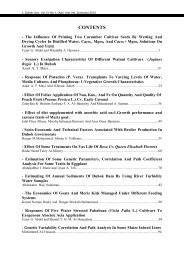Create successful ePaper yourself
Turn your PDF publications into a flip-book with our unique Google optimized e-Paper software.
J. Duhok Univ., Vol.14, No.1 (Pure and Eng. Scienes), Pp 17-24, 2011<br />
GENETIC DIVERSITY ASSESSMENT AND VARIETY IDENTIFICATION<br />
OF PEACH (Prunus persica) FROM KURDISTAN<br />
REGION-IRAQ USING AFLP MARKERS<br />
SHAYMAA H. ALI<br />
Scientific Research Center, University of Duhok. Kurdistan Region-Iraq<br />
(Received: January 25, 2010; Accepted for publication: February 27, 2011)<br />
ABSTRACT<br />
The peach (Prunus persica) is an important member of the Rosaceae family, which contains many fruit, nut, and<br />
ornamental species. It has a basic chromosome number of 8. Amplified fragment length polymorphisms (AFLP)<br />
markers were used to determine the level of genetic diversity, genetic relationships, and fingerprinting of peach<br />
varieties cultivated in Kurdistan- Iraq. A total of 21 samples have been collected from different districts of Kurdistan<br />
including Duhok, Erbil and Sulaymani. The samples were analyzed by using AFLP markers. Two primer<br />
combinations generated a total of 124 bands and among them 109 (87.9%) were polymorphic. Using UPGMA<br />
clustering analysis method based on the similarity coefficient, varieties were separated into three major genetic<br />
clusters. The first genetic cluster mostly includes (Korneet asfer, Floredasin, Motaem bkornet mobaker (ahmer),<br />
Sprink time, Nectar 4, Nectar 6, Ahmer myse, Badree, Mskee, Tenee, Esmailly, Migrant, Abo-zalma, Silverking). The<br />
second genetic cluster includes (Read heaven, Sharly shapor). While the third genetic cluster contains (Zard, Elberta,<br />
Zaefaran, Dixired, j. h. hale). Genetic distance among 21 peach varieties were ranged from 0.0073 to 0.8572. The<br />
lowest genetic distance (0.0073) was found between varieties (Tenee) and (Esmailly) which were collected from Erbil,<br />
whereas the highest genetic distance (0.8572) was found between varieties num (Badree) and (Elberta) collected from<br />
Duhok and Sulaymani respectively. The results obtained in this study may assist peach cultivation and peach breeding<br />
programs in the region.<br />
KEYWORDS: - Peach (Prunus persica), Genetic Diversity, AFLP-Markers.<br />
T<br />
INTRODUCTION<br />
he peach (Prunus persica) is one of the<br />
species of genus, Prunus, native to<br />
China that bears an edible juicy fruit. It is a<br />
deciduous tree growing to 5-10m tall, and it is an<br />
important member of the Rosaceae family,<br />
which contains many fruit, nut, and ornamental<br />
species having a basic chromosome number of 8<br />
(Wang et al. 2002). The scientific name persica,<br />
along with the word "peach" itself and its<br />
cognates in many European languages, derives<br />
from an early European belief that peaches were<br />
native to Persia. The modern botanical<br />
consensus is that they originate in China, and<br />
were introduced to Persia and the Mediterranean<br />
region along the Silk Road before Christian<br />
times (Huxley 1992).<br />
Polymerase chain reaction (PCR)-based<br />
methods for genetic diversity analyses have been<br />
developed, such as random amplified<br />
polymorphic DNA (RAPD), amplified fragment<br />
length polymorphism (AFLP), and inter simple<br />
sequence repeat (ISSR/SSR). Each technique is<br />
not only differed in principal, but also in the type<br />
and amount of polymorphism detected. AFLP<br />
technique is based on the selective PCR<br />
amplification of restriction fragments from a<br />
total digest of genomic DNA. The technique<br />
involves three basic steps: (1) restriction of the<br />
DNA and ligation of oligonucleotide adapters,<br />
(2) selective amplification of sets of restriction<br />
fragments, and (3) gel analysis of the amplified<br />
fragments (Vos et al. 1995).<br />
Recently, the use of Amplified fragment<br />
length polymorphisms (AFLP) in genetic marker<br />
technologies has become the main tool due to its<br />
capability to disclose a high number of<br />
polymorphic markers by single reaction, high<br />
throughput, and cost effective (Jones et al.<br />
1997). AFLP have been widely utilized markers<br />
for constructing genetic linkage maps and<br />
genetic diversity analysis. It is a useful<br />
technique for breeders to accelerate plant<br />
improvement for a variety of criteria, by using<br />
molecular genetic maps to undertake markerassisted<br />
selection and positional cloning for<br />
special characters. Molecular markers are more<br />
reliable for genetic studies than morphological<br />
characteristics because the environment does not<br />
affect them (Vos et al. 1995).<br />
AFLP markers have successfully been used<br />
for analyzing genetic diversity in some other<br />
plant species. It has been proven the most<br />
efficient technique estimating diversity in barley<br />
(Russel et al. 1997), provides detailed estimates<br />
of the genetic variation of papaya (Kim et al.<br />
2002), and have been used to analyze the genetic<br />
17



